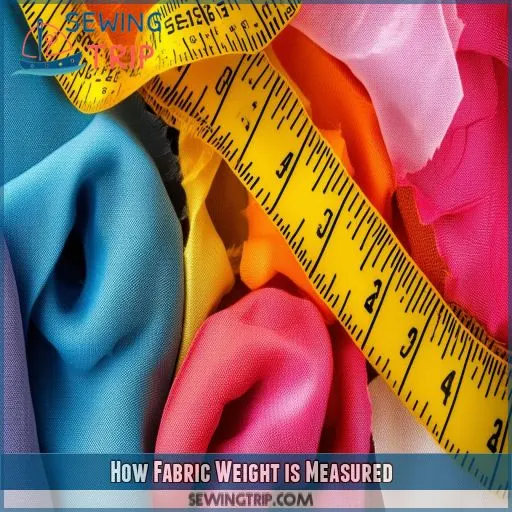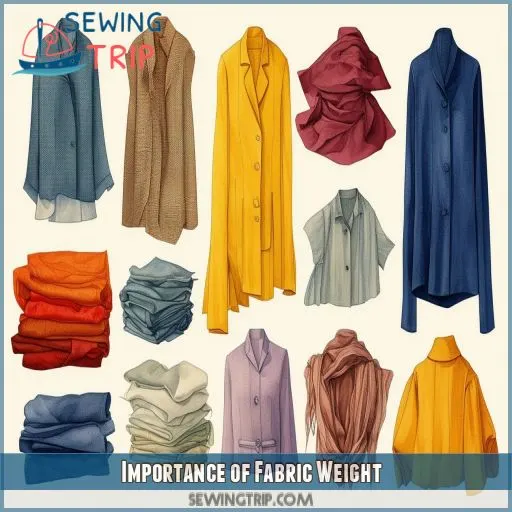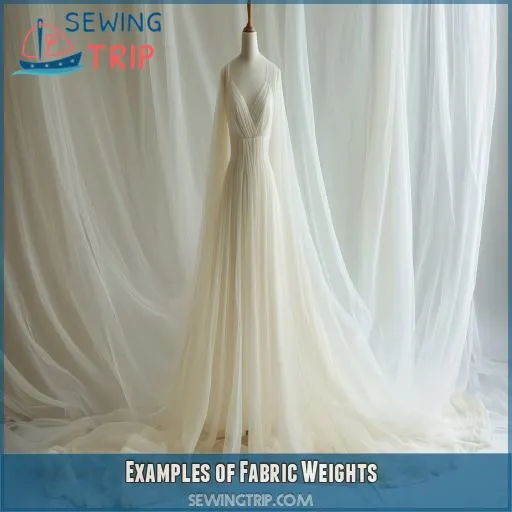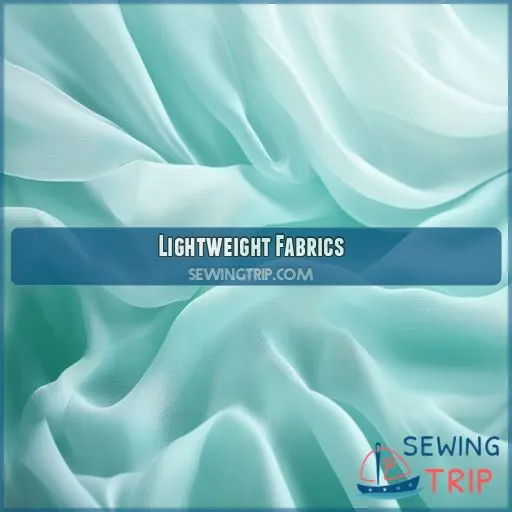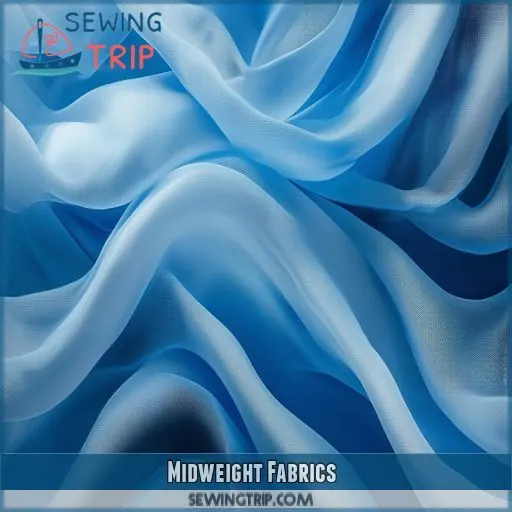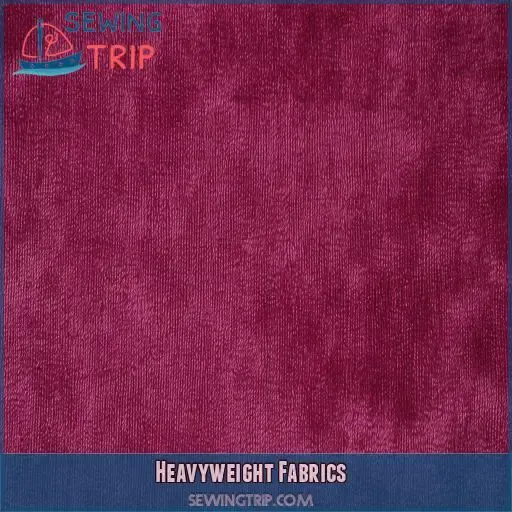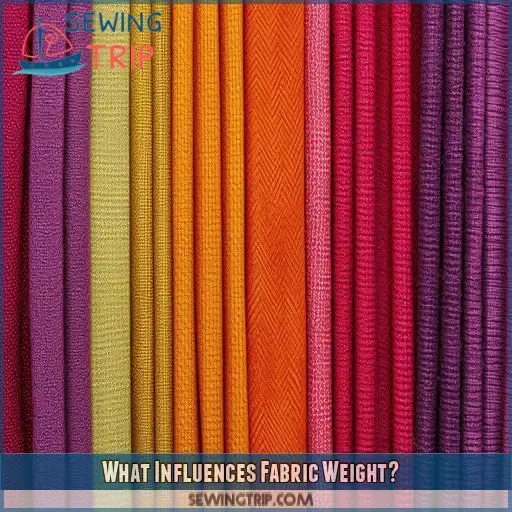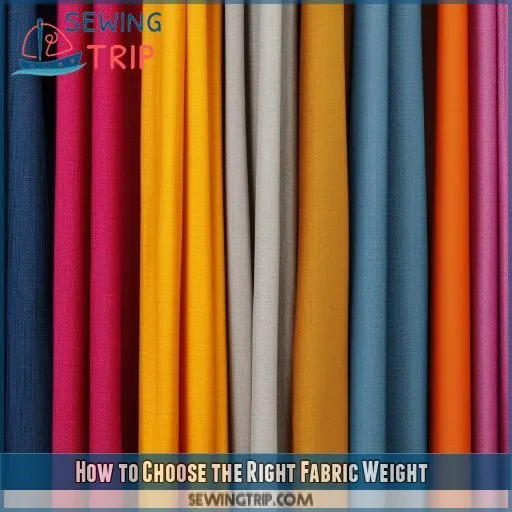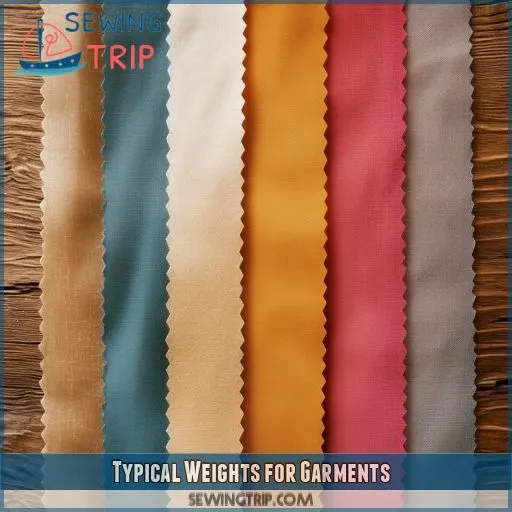This site is supported by our readers. We may earn a commission, at no cost to you, if you purchase through links.
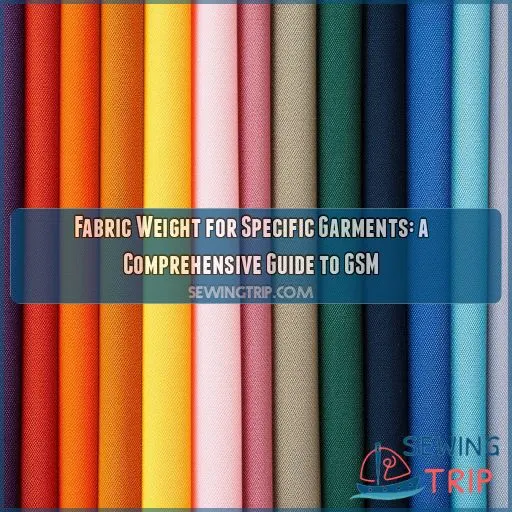
This thorough guide will explore the realm of GSM (grams per square meter), providing you with a clear understanding of fabric weight and its impact on specific garments.
You’ll explore lightweight, midweight, and heavyweight fabrics, along with the factors that influence their weight, such as fiber content and weaving techniques.
Additionally, you’ll discover how to choose the right fabric weight for your projects, considering factors like project type, climate, and sewing skill level.
Table Of Contents
Key Takeaways
- Fabric weight is crucial: It’s like the foundation of a house, affecting drape, function, and durability.
- GSM (grams per square meter) is the measure: Lightweight fabrics are under 150 GSM, midweight is 150-350 GSM, and heavyweight is 350+ GSM.
- Fabric weight depends on fiber content and weaving techniques: Natural fibers are lighter, synthetics are heavier, and weaving density impacts weight too.
- Choose fabric weight based on the project, climate, drape, and skill level: Lighter weights for summer, heavier for structure, and practice makes perfect for sewing heavy fabrics.
How Fabric Weight is Measured
Fabric weight, or fabric density, is measured in grams per square meter (GSM) or ounces per square yard (oz/yd²).
To determine the weight of a fabric, you need to take a sample of the fabric, cut it into a precise size, and then weigh it.
The standard sample size is 10 centimeters by 10 centimeters, or 100 square centimeters.
You then multiply the weight of the sample by 100 to get the GSM, or convert it to oz/yd² by multiplying by 0.0295.
It’s important to guarantee accuracy in your measurements by preparing your fabric sample properly and taking multiple readings.
Let the fabric rest for 24 hours before measuring to make sure it’s in a relaxed state, and take the average of several readings to account for any variations.
This process gives you an accurate idea of the fabric’s weight and density, critical when selecting fabrics for specific projects.
Importance of Fabric Weight
Now that you know how fabric weight is measured, it’s time to understand why it matters.
Fabric weight, or GSM, plays a significant role in determining the characteristics of a fabric and its suitability for specific garments.
It influences fabric breathability, warmth, drape, feel, and durability.
For example, lightweight fabrics (under 150 GSM) are thin and breathable, making them ideal for summer clothing and scarves.
On the other hand, heavyweight fabrics (over 350 GSM) are thick and durable, perfect for outerwear and upholstery.
The weight of a fabric also affects its drape, with lighter fabrics creating a softer, more fluid drape, while heavier fabrics result in a stiffer, more structured drape.
Examples of Fabric Weights
As you now know, fabric weight is a significant factor in determining the characteristics of a fabric, including its drape, transparency, stiffness, durability, and comfort.
Here are some examples of fabric weights and their corresponding categories:
- Lightweight Fabrics: Typically under 150 GSM, lightweight fabrics include materials like chiffon, silk, and lightweight cotton. They’re known for their thin, breathable, and softly draping qualities.
- Medium-Weight Fabrics: Usually ranging from 150 to 350 GSM, medium-weight fabrics include denim, linen, and medium-weight cotton. These fabrics offer a balance between durability and comfort, with a good drape that isn’t too stiff or too flowy.
- Heavyweight Fabrics: Weighing in at over 350 GSM, heavyweight fabrics are perfect for upholstery and include materials such as canvas, heavy denim, and upholstery fabric. Their thickness and durability result in a stiffer drape, making them ideal for structured projects.
Lightweight Fabrics
Lightweight fabrics, typically under 150 GSM, are characterized by their thin, breathable nature and soft drape. Chiffon, silk, and lightweight cotton are common materials in this category. The weight of these fabrics makes them ideal for summer clothing, scarves, and undergarments. They offer a delicate and airy feel, perfect for a flowy and comfortable fit.
When working with lightweight fabrics, consider their breathability and transparency. These fabrics are ideal for hot climates, as they allow air circulation and provide a cooling effect. However, their sheer nature may require lining or layering to achieve the desired opacity for different garments.
Additionally, lightweight fabrics are generally easier to sew and work well for beginners. Their soft drape creates a graceful and fluid silhouette, making them a popular choice for blouses, skirts, and dresses.
Midweight Fabrics
Midweight fabrics, typically ranging from 150 to 350 GSM, strike a balance between lightweight and heavyweight options. They’re commonly used for garments that require a combination of durability and comfort, such as:
- Button-down shirts
- T-shirts
- Khakis
Here are some key considerations for midweight fabrics:
- Durability: Midweight fabrics offer a good balance between strength and flexibility, making them suitable for garments that need to withstand regular wear and tear without sacrificing comfort.
- Comfort: The weight of these fabrics provides a nice drape, making them ideal for clothing that should hang well and move with the body.
- Opacity: Midweight fabrics tend to have better opacity than lightweight options, providing more coverage and making them suitable for a wider range of garments.
- Cotton fabric weight: In the case of cotton, a midweight fabric (around 275 GSM) will give your garment more structure without sacrificing breathability.
Heavyweight Fabrics
When it comes to heavyweight fabrics, you’re looking at materials with a GSM of 350 or higher. These fabrics are thick, durable, and have a stiff drape, making them perfect for projects that need a bit of structure. Think heavyweight canvas for tote bags, durable denim for jeans, or upholstery fabric for that new armchair you’ve been eyeing. Wool options also fall into this category, keeping you cozy during the colder months.
It’s important to keep in mind the season when working with heavyweight fabrics. You wouldn’t want to wear a heavy wool coat in the middle of summer, and similarly, a lightweight linen shirt wouldn’t provide much warmth in the depths of winter. So, when choosing your fabric, think about the intended use and the climate you’ll be using it in.
What Influences Fabric Weight?
Several factors influence fabric weight, including the type of fiber used, the weaving or knitting technique, and any finishing treatments applied. For example, natural fibers tend to create lighter fabrics, while synthetic fibers result in heavier ones.
Fiber Content
Fiber content plays a significant role in determining fabric weight, and different fibers have unique characteristics that influence the weight and properties of the fabric. Here are some key points to note:
- Fiber Quality: The inherent quality of the fiber affects the weight. For example, natural fibers like cotton and wool tend to be lighter, while synthetic fibers like polyester and nylon can be heavier.
- Fiber Weight: Individual fibers have varying weights, and when spun into yarns and woven or knit into fabrics, the fiber weight contributes to the overall fabric weight.
- Fiber Blends: Blending different fibers can impact fabric weight. For instance, a blend of cotton and polyester may result in a fabric with a different weight compared to using either fiber alone.
- Fiber Drape and Strength: The weight of the fiber influences the drape and strength of the fabric. Heavier fibers often create a more structured drape, while lighter fibers offer a softer, more fluid drape.
Weaving and Knitting
The impact of knitting and weaving density on fabric weight is significant.
In the context of weaving, the warp and weft threads’ closeness, or density, influences the weight.
A tightly woven fabric with a higher thread count will be heavier than a loosely woven one.
Knitted fabrics, on the other hand, tend to be stretchier and less structured, which can result in variations in weight.
Finishing Treatments
Finishing treatments are processes applied to fabrics after weaving or knitting to enhance their appearance, performance, or feel.
These treatments can impact the weight of the fabric, influencing its drape, durability, transparency, and breathability.
For example, brushing the fabric can create a softer, fluffier texture, adding a small amount of weight.
Coatings can also be applied to fabrics to make them waterproof or stain-resistant, which typically adds more weight and affects the fabric’s drape and breathability.
How to Choose the Right Fabric Weight
When choosing the right fabric weight, consider the type of project, the climate, the drape, your sewing skill level, and any pattern requirements. For example, lightweight fabrics are ideal for summer clothing and scarves, while heavyweight fabrics are better suited for outerwear and bags.
Considerations for Project Type
When choosing a fabric for your project, consider the type of garment you’re creating.
Fabric weight plays a vital role in the final product’s comfort, durability, drape, and application.
For example, lightweight fabrics are ideal for summer clothing and scarves,
while medium-weight fabrics are versatile for everyday clothing and home decor.
Heavyweight fabrics are perfect for outerwear and upholstery due to their durability and structure.
Considerations for Climate
When selecting the appropriate fabric weight, it’s imperative to contemplate the climate in which you’ll be wearing your garments. Here are some key factors to bear in mind:
- Seasonal Suitability: Opt for lightweight fabrics during hot summers to remain cool and comfortable.
- Garment Breathability: Breathable fabrics are essential for maintaining comfort in warm climates.
- Layering Considerations: In cooler climates, choose medium-weight fabrics that facilitate easy layering.
- Comfort Levels: Select fabrics with the appropriate weight to guarantee comfort in any weather.
Considerations for Drape
When choosing a fabric, consider drape vs. flow, weight vs. stiffness, thickness vs. breathability, and opacity vs. transparency.
A lightweight fabric like chiffon drapes softly, while a heavyweight fabric like denim has a stiffer drape.
Thicker fabrics provide more insulation and comfort, while lighter fabrics offer breathability.
For a structured look, opt for heavier weights, but for flow and movement, go with lighter options.
Fabric weight impacts drape, so choose wisely for your desired effect.
Considerations for Sewing Skill Level
When choosing a fabric weight, consider your sewing skill level.
If you’re a beginner, opt for lightweight or medium-weight fabrics with simple weaves and patterns.
These are easier to work with and will help you develop your skills.
Heavyweight fabrics, complex weaves, and bulky materials can be more challenging to sew and may require advanced techniques.
Considerations for Pattern Requirements
When choosing a fabric, consider the pattern requirements. This includes the fabric texture, drape characteristics, your sewing machine type, seam allowances, and any pattern adjustments you may need to make.
For example, if you’re working with a delicate fabric that has a soft drape, you’ll want to use a sewing machine with a gentle feed to prevent the fabric from being pulled and stretched.
Typical Weights for Garments
When discussing specific garments, the fabric weight, or GSM, plays a significant role in their overall appearance and feel. Lightweight garments typically fall in the 0-150 GSM range, while medium-weight pieces are between 150 and 300 GSM. Heavyweight garments, on the other hand, start at 300 GSM and go up from there.
Lightweight Garments (0-150 GSM)
Lightweight fabrics, typically under 150 GSM, are characterized by their sheerness, breathability, and soft drape. They’re perfect for creating a delicate and airy feel in garments. Here are some typical weights for garments in this category:
- Blouses
- Scarves
- Lightweight cotton voile
Lightweight fabrics are often used for summer clothing, undergarments, and scarves due to their comfort and softness. They drape easily and provide a relaxed, effortless look.
Medium Weight Garments (150-300 GSM)
Medium-weight fabrics, typically ranging from 150 to 300 GSM, strike a balance between durability and comfort. They’re versatile and suitable for everyday clothing, offering breathability without sacrificing structure.
| Fabric Type | GSM Range | Characteristics |
|---|---|---|
| Denim | 170-240 | Durable, casual |
| Linen | 150-250 | Breathable, crisp |
| Cotton Twill | 200-280 | Soft, versatile |
| Wool Flannel | 200-300 | Warm, comfortable |
Heavyweight Garments (300+ GSM)
Heavyweight fabrics are typically used for durable, outdoor garments that provide warmth and protection.
With a GSM of 300 or more, these fabrics are thick and sturdy, making them ideal for coats, outerwear, and upholstery.
Heavyweight denim, canvas, and wool are common choices for this category, offering a stiff drape and superior durability.
If you’re looking for a fabric that can withstand the elements and provide a substantial feel, this weight range is a perfect choice.
Frequently Asked Questions (FAQs)
How much does fabric weigh?
Fabric weight varies. It’s measured in grams per square meter (GSM) or ounces per square yard (OZ/Y2). Lightweight fabrics are under 150 GSM, medium-weight fabrics are 150-350 GSM, and heavyweight fabrics are over 350 GSM.
What are the different types of fabric weights?
Fabric weights are typically classified into three categories: lightweight, medium-weight, and heavyweight.
Lightweight fabrics are 150 gsm or less, medium-weight fabrics range from 150 to 350 gsm, and heavyweight fabrics are 350 gsm or more.
For example, chiffon and linen are lightweight, while denim and canvas are heavyweight.
How much GSM does a fabric weigh?
Fabric weight is measured in grams per square meter (GSM). The weight varies depending on the type of fabric, with lightweight fabrics typically under 150 GSM, medium-weight fabrics between 150 and 350 GSM, and heavyweight fabrics over 350 GSM.
What is a medium weight fabric?
Medium weight fabrics are those that weigh between 150 and 350 GSM. They’re versatile and ideal for everyday clothing. Examples include velvet, nylon, and sateen.
How do you calculate fabric for garments?
Calculating fabric weight is like solving a puzzle, with each piece being essential to the final picture. You start by cutting a 10cm x 10cm sample, weighing it, and then multiplying that weight by 100 to get the grams per square meter (GSM).
How is garment weight calculated?
Garment weight is calculated by multiplying the fabric volume by its density. Measure the length, width, and thickness of the fabric, and weigh it. The weight is recorded in ounces or grams, and the fabric is classified by weight.
What determines fabric weight?
The material a fabric is made from is the biggest determining factor of its weight. The atomic density of a fabric’s material affects its weight. Additionally, fabric weight can be altered using yarn count, fabric count, fabric construction, and mechanical and chemical treatments.
What does 500 GSM mean for hoodies?
A 500 GSM hoodie is considered a very heavy-weight hoodie, well above the typical range of 300-350 GSM. It will be thick, warm, and ideal for extremely cold weather.
How can I identify fabric weight?
If you want to identify fabric weight, you can use a circle cutter, a ruler, a pen, or a fabric weight conversion calculator. Or, you can weigh it in your hands and make an educated guess.
How does weight affect fabric performance?
Fabric weight affects drape, flow, transparency, and breathability. Lighter fabrics have a softer drape, flow more elegantly, and are more breathable. Heavier fabrics have a stiffer drape and are more opaque.
What mistakes are commonly made when choosing fabric weight?
A common mistake is assuming a fabric’s weight based on its appearance. For instance, denim is heavier than chiffon due to its weave and fibres. Another error is choosing a fabric too thick for your sewing machine.
Can lightweight fabrics be used for heavyweight garments?
No, lightweight fabrics aren’t suitable for heavyweight garments. Lightweight fabrics are typically used for summer clothing, underwear, and dresses, whereas heavyweight fabrics are used for outerwear and upholstery.
Does fabric weight impact price?
Fabric weight is a key indicator of price. A higher fabric weight often means a higher price, as heavier fabrics are typically more durable and made from more expensive materials. However, be cautious of discrepancies between advertised and actual fabric weights.
Conclusion
Now that you’ve explored the complexities of fabric weight and its impact on specific garments, you’re equipped with the knowledge to make informed choices for your projects.
You understand the significance of GSM and can discern between lightweight, midweight, and heavyweight fabrics.
With this guide, you can confidently select the right fabric weight, considering project requirements, climate, drape, and your sewing expertise.

